Days 8 – 19 Adina crosses the Pacific Ocean
1Saturday 3 May 2014
On day 8, our SSB radio that allows us to send e-mails and blogs from the boat decided we should stay isolated from the world, wouldn’t play fair and added itself to the repair list.
Being at sea for so long you try and slip into some form of routine but at the same time have a bit of variety to keep yourself occupied. Most days we’d each have a go at helming rather than relying on George the autopilot who did a lot of looking after us at night time. George on the whole is a better helm than us so when we were steering really deep downwind his workload was upped. One area we are better than George is when the sea state gets awkward, he’s blind as a bat so can’t see the waves and we often take over. George does make a squeaking sound as he moves – James at first thought the noise was Susie sleeping rather heavily!
Most days by 11am we were all up and porridge was our favourite choice for breakfast. Seems an odd choice in all the heat but it keeps you going. Tom liked his with bananas, raisins and heaps of honey while Susie and James went local swapping the honey for passion fruit. In the Galapagos we had bought a tree of bananas (not sure of the exact term but that’s what we called it) and hung it off the aft starboard quarter. It slowly ripened and produced the tastiest bananas any of us had ever enjoyed. But they do ripen fast and Susie was soon treating us to some heavenly banana bread!
Food of course plays an important role and Susie likes taking charge in this department – and like the Atlantic we ate like royalty! During the day a protein would be chosen and then we’d all discuss what to make with it, new recipes flowed. On board we have a pressure cooker that saves time and valuable gas. Come 5pm the boys would be given a heap of chopping and this ‘team chop’ soon became a favourite part of the day. Of course Susie was given nights off and the boys would cook, cursing away as they got thrown around the kitchen, burning themselves etc. etc. Freshly baked bread and rolls were another highlight and the boys set themselves the task of producing a loaf of bread each and for the record the results were pretty good. But we could never match Susie’s endless flow of cake and cookies.
Susie is always on the outlook for fresh food that will last long ocean passages and had found a rather large pumpkin. It did last but being rather large we were then pushed to use it in as many recipes as we could. Tasty pumpkin soup in various guises were made and it then also got used in a stew, a curry and a Bolognese to go with pasta! We still had some leftover for the end and gave some to friends when we arrived in Hiva Oa!
We all took an interest in keeping Adina moving and often sat trying different options with the sail trim given the variable conditions. We soon went through the full remit of flying our parasailor, goose-winging (main and jib on opposite sides to each other), jib only and the more challenging option of keeping her moving in light winds. Adina has some big heavy sails and in light winds it often pays to reef (put away) some of the sail as light winds battle to fill the sails. Luckily we didn’t have too much light wind as it can be very frustrating and you trundle off your course trying to keep pressure in the sails.
In between helming, reading, cat-napping and cooking, each day we’d try and have some project to fill our time and count down the days. On the repair list was our Hamilton Ferris towable generator. Patiently in testing seas we checked every cable and even replaced cables but to no avail – it wouldn’t work. It’s been a big disappointment, we’ve spent good money on it, it failed in the Atlantic and now we have to wait and see what Hamilton Ferris will do to repair it hopefully without the mind blowing shipment charges we’ve incurred before.
We counted down the days with Tom declaring if it was a good day or a ‘no-nothing’ day as he deemed it. Good days were days like being two-thirds of the way or passing through, for example, the 1000 mile mark. No-nothing days were numbers he just didn’t fancy. 10 days to go was good as it’s a nice number, 9 days were good as we were into single digits but 8 days to go was a no-nothing day –a number that meant nothing. And woe betide 4 days to go – it was the worst. 5 days is a nice number and of course 3-2-1 are all good days. But day 4, you want to get excited but in reality it’s still a long way to go, the same time as crossing the Bay of Biscay. James didn’t like the game as he feared we’d not make the crossing in the time we were promising but despite a little last minute wobble as the winds went light Tom was right and we got there in 19 days.
An ocean crossing is a marathon not a sprint and we never push Adina on ocean crossings. Every night we had a debate of whether or not to reduce the sails. We’d experienced the 40 plus knots of winds in the squalls of the Atlantic and unless the winds were really settled we’d take some sail down at night. At times we could see it frustrated the racer in James but we know, as do all boat owners, you want your boat in one piece, you don’t want the rigging falling over, we will not push it. Boats are put under so much stress in open oceans with the waves shaking it in every direction. We always say picture putting your home on an ocean and see how it is shaken, not to mention the damage from constant salt and sun.
As we proceeded west the winds went more behind us and at times lightened meaning we could hoist our parasailor (spinnaker). It’s always exciting and we love sailing with it. It takes us in the right direction and the boat stabilises and life is so much easier on board. Every 12 hours we move the halyard to reduce any chance of chafe. After a day and a half with it up Tom was helming when he cried out ‘Oh heck’ (well ok, heck wasn’t the exact word). The halyard blew and our parasailor came drifting down into the sea. We all dashed to try and retrieve it out of the sea as it dragged in the water like a huge drogue. The boat eventually slowed and we heaved with every effort, our muscles aching as it was filled with water. We had invested too much in it and we weren’t letting it go. Bit by bit working together we heaved it out of the water, trying to unload the water that had become trapped weighing it down. Finally we had it on deck. We couldn’t understand why the halyard had blown, it was a year old and had been used less than 10 times. We got our white sails out and kept sailing, feeling a little dejected. Next we set to drying out our 165 sq feet of spinnaker, no easy task on a boat. Luckily we had sun and wind. That meant the next day’s project was sorting out the horrible twisty mess it had become. Patiently we untwisted it. The parasailor has a big wing out the front and this is full of little strings and we checked each and every single one. Eventually we sorted it and got it packed in its sock. We were actually pleased we had not only got it out of the sea but we had it all set to go again.
In the meantime the winds picked up so we goose-winged. We have our genoa pinned out to the one side on the end of a spinnaker pole while the main sail is held out with a preventer line (a line that holds the boom fixed in place) to the other side. While it is useful in keeping you on your course, it’s our least favourite point of sail as the boat rolls from side to side making life very difficult and uncomfortable. You struggle to sleep never mind cooking and washing dishes!
Every day we’d have sundowners (alas without alcohol) and some form of nibbles. Most boats sail oceans ‘dry’, truth be told more to have a break from social drinking and to lose weight than anything else! Dinner was served and then we’d go into our night watches. We did single watches meaning one person was awake with the others sleeping but on stand-by. Having James as crew was heaven for us as it meant three hours on, six hours asleep. We were trying a new system of using a fixed rota and trying to suit it to what our individual body clocks favoured. Tom took the first shift of 9 to 12, Susie was on 12 to 3, James 3 to 6 and Tom 6 to 9 with everyone typically up by 11am even though day shifts existed too but we always swapped in and out of those. The fixed rota system worked well and we deemed it a success. Every 15 degrees of longitude we’d turn the clock back an hour.
Every day we’d look out and see nothing but blue sea 360 degrees around us. One night Tom and Susie saw a ship but other than that nothing. Indeed James saw nothing the entire trip and as we got closer to our destination, he decided the world had ended and the Marquesas Islands had sunk and we’d sail right over them.
As we neared our destination the winds got a little lighter and changed direction. It was time to hoist the parasailor. We were a little nervous but up it went and much to our delight it flew beautifully. But we nursed it and moved the halyard to prevent any chafe – this halyard was even newer and only seen three days of service in the Atlantic. On our last night at sea we decided conditions were calm enough to fly it overnight. Tom was on the night shift and suddenly there was a plop. Unbelievably the second halyard had blown and on a night with no moon we were faced with hauling it out of the sea once more. Using all our strength we got it on board once more, tying it down on the back deck to be dealt with in daylight. With less than 24 hours to our destination we should have been excited, but we were now left dejected. It’s a real shame as we look after it so well, we’ve invested heavily ensuring all the gear is top quality, we always clean the lines, blocks, we use soft shackles to prevent chafe etc. Just not fair.
Day 19 dawn rose and land was sighted. We put our parasailor woes behind us and admired the huge soaring land masses of the Marquesas Islands. As we sailed along the south coast of the island Hiva Oa we were in awe. Steep sided, it sears out of the sea, intensely green and lush with the hills covered in trees and the shore scattered with coconut trees. Above it flew the black frigate birds we now know so well. It was like taking a walk in a National Geographic magazine. In high spirits we headed into the little bay of Atuona. Atuona is the first official check-in point. It’s a small rolly anchorage and was crowded with yachts making their first landfall. We found a spot and using both a bow anchor and stern anchor pinned ourselves in position. Surrounded by steep sided hills, again lush and full of trees, we wanted to pinch ourselves as the sun shone bright. It called for a champagne lunch in celebration; we had crossed the Pacific Ocean and now we were in French Polynesia. It would take a long time for our smiling to stop.
To James we offer our thanks. We couldn’t have asked for a single inch more, he mucked in with everything, helping out wherever he could, jumping at the opportunity to be involved, we loved our sessions on sail trim, he kept us amused with his stories and he thrived on it. We hope crossing the Pacific Ocean from the Galapagos Islands to the Marquesas will live in your memory as long as it surely will in ours.
So with two ocean crossings in the space of five months Adina now settles down to exploring the many islands of the Pacific. The next three months we plan to explore French Polynesia, including the Marquesas Islands, Tuamotos, and the Society Islands. In the immediate future we will spend the next 3-4 weeks exploring the imposing Marquesas Islands. Excited? Most certainly!

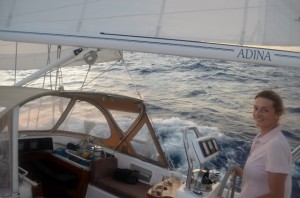
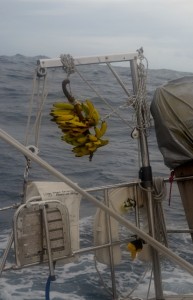
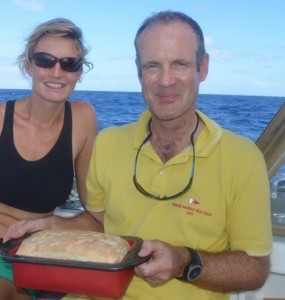
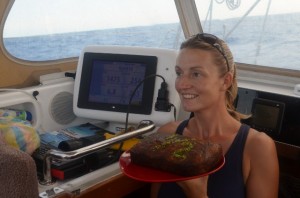
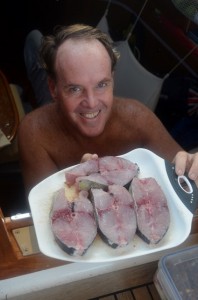
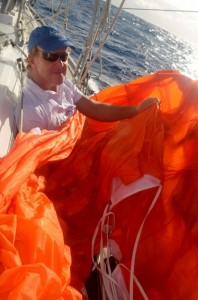
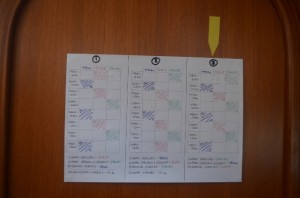
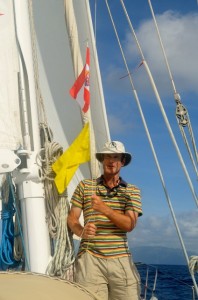
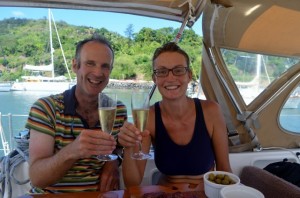
Fab blog. So good to hear its all going so well. One hell of a trip hey! All the best for a few weeks chilling around the islands and let the wind gods be on your side for all that follows. S x